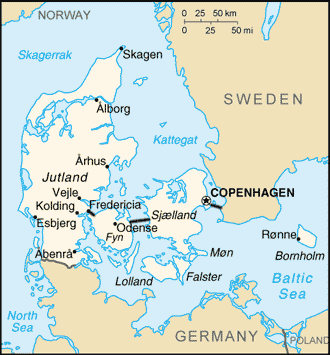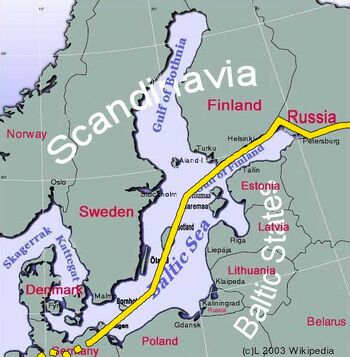Denmark

Denmark (डेन्मार्क) is a state in the Scandinavian region of Northern Europe with the two autonomous constituent countries in the north Atlantic Ocean, the Faroe Islands and Greenland.
Location
Denmark is the southernmost of the Nordic countries, located southwest of Sweden, south of Norway and bordered to the south by Germany. Denmark consists of a peninsula, Jutland, and the Danish archipelago of 407 islands, comprising of Zealand, Vendsyssel-Thy, Funen, Lolland, Falster, Bornholm.

History
Most handbooks derive[21] the first part of the word, and the name of the people, from a word meaning "flat land", related to German Tenne "threshing floor", English den "cave", Sanskrit dhánuṣ- (धनुस्; "desert"). The -mark is believed to mean woodland or borderland, with probable references to the border forests in south Schleswig.
Historians believe that before the arrival of the precursors to the Danes, who came from the east Danish islands (Zealand) and Skåne and spoke an early form of North Germanic, most of Jutland and the nearest islands were settled by Jutes. They were later invited to Great Britain as mercenaries by Brythonic King Vortigern and were granted the southeastern territories of Kent, the Isle of Wight among other areas, where they settled. They were later absorbed or ethnically cleansed by the invading Angles and Saxons, who formed the Anglo-Saxons. The remaining population in Jutland assimilated in with the Danes.
German Effect on Jutland
Mangal Sen Jindal[1] writes....German Effect on Jutland: "The Danish language belongs to the East Scandinavian group of Germanic languages. The national religion, to which the bulk of the population belongs, is Lutheran Evangilical. The only non-Danish minority is a German element." [2]
"Migrations and invasions from the continent early flowed across the open borderland of Jutland. By the same route came culture currents from Western Europe and Germany, which Denmark received and adapted to her own genius. But even in the Iron Age, with its vigorous economic and social development, Danish tribes trekked across Europe towards Germany and Italy and sailed their vessels to Britain. This first great expansion was followed from about 500-600 A.D. by another, which along with Norwegian Viking raids to the west and Swedish to the east, continued for several centuries and culminated around 900-1000 A. D." [3]
"The Juts of Jutland expanded to Cologne, Paris, Nantes, Spain, Camargue Luna (Italy) Greece, Constantinopel, Novgorod (USSR), Kiev, Itil and Semender etc., all prior to 1000 A.D." ...... Denmark Official Handbook, page 71. Refer to the map in this Chapter dealing with migration and immigration of Jats.
"Towards the end of eighth century A. D. Viking seafarers began a series of raids from the North. The roads marked the start of the Viking rea, a span of some 250 years when a tremendous outpouring of energy carried man of the North to such far flung places as Greenland and Bagdad.
History of Origin of Some Clans in India:End of p.92
During the Viking Era these people colonized parts of England and France and all of Sicily. They established the first Russian kingdom. They traded slanes and furs for Chinese silks and Arab Silver in the markets of Bagdad." Who discovered America by Patricia Lauber published by Randon House, New York-pages 79 and 80.
The viking expansion had important consequences for development in Denmark itself. Riches, slaves and foreign culture were imported; at the same time those who stayed at home cleared large tracts of forest and built many new villages. Large farmers became estate-owners. " [4]
"The new influence flowing from the South reached Denmark chiefly through North Germany. A culture which flourished among enterprising merchants and artisans of the Hanseatic towns exerted a profound influence, also linguistically, on Denmark." [5]
"Of the Judicial system before 1200 there is only very incomplete knowledge, but by about 1200 A. D. there were three separate areas of jurisdiction, each with its own law; The Jutland code, the Zealand code and the Scanean code. The last-named gradually lost their importance and were superseded by the Jutland area." [6]
It is difficult to study religious history of Jutland of prior to 826 A.D. when "Christianity was introduced in 826 by the mission of the Benedictine monk Ansgar, from northern France. But it was not adopted until 960....When the king had himself baptized and ordered the religion's introduction." [7]
The only non-Danish minority is a German element in South Jutland numbering about 40,000 or less than 0.8 percent of the population. Big industrial expansion has caused a large immigration of foreign workers, totaling 54,000 (1972).
Jat History
- Burdak surname of Jats is found in Denmark. See
प्राचीनकाल में यूरोप देश
दलीप सिंह अहलावत[8] लिखते हैं: यूरोप देश - इस देश को प्राचीनकाल में कारुपथ तथा अङ्गदियापुरी कहते थे, जिसको श्रीमान् महाराज रामचन्द्र जी के आज्ञानुसार लक्ष्मण जी ने एक वर्ष यूरोप में रहकर अपने ज्येष्ठ पुत्र अंगद के लिए आबाद किया था जो कि द्वापर में हरिवर्ष तथा अंगदेश और अब हंगरी आदि नामों से प्रसिद्ध है। अंगदियापुरी के दक्षिणी भाग में रूम सागर और अटलांटिक सागर के किनारे-किनारे अफ्रीका निवासी हब्शी आदि राक्षस जातियों के आक्रमण रोकने के लिए लक्ष्मण जी ने वीर सैनिकों की छावनियां आवर्त्त कीं। जिसको अब ऑस्ट्रिया कहते हैं। उत्तरी भाग में ब्रह्मपुरी बसाई जिसको अब जर्मनी कहते हैं। दोनों भागों के मध्य लक्ष्मण जी ने अपना हैडक्वार्टर बनाया जिसको अब लक्षमबर्ग कहते हैं। उसी के पास श्री रामचन्द्र जी के खानदानी नाम नारायण से नारायण मंडी आबाद हुई जिसको अब नॉरमण्डी कहते हैं। नॉरमण्डी के निकट एक दूसरे से मिले हुए द्वीप अंगलेशी नाम से आवर्त्त हुए जिसको पहले ऐंग्लेसी कहते थे और अब इंग्लैण्ड कहते हैं।
द्वापर के अन्त में अंगदियापुरी देश, अंगदेश के नाम से प्रसिद्ध हुआ, जिसका राज्य सम्राट् दुर्योधन ने अपने मित्र राजा कर्ण को दे दिया था। करीब-करीब यूरोप के समस्त देशों का राज्य शासन आज तक महात्मा अंगद के उत्तराधिकारी अंगवंशीय तथा अंगलेशों के हाथ में है, जो कि ऐंग्लो, एंग्लोसेक्शन, ऐंग्लेसी, इंगलिश, इंगेरियन्स आदि नामों से प्रसिद्ध है और जर्मनी में आज तक संस्कृत भाषा का आदर तथा वेदों के स्वाध्याय का प्रचार है। (पृ० 1-3)।
यूरोप अपभ्रंश है युवरोप का। युव-युवराज, रोप-आरोप किया हुआ। तात्पर्य है उस देश से, जो लक्ष्मण जी के ज्येष्ठपुत्र अङ्गद के लिए आवर्त्त किया गया था। यूरोप के निवासी यूरोपियन्स कहलाते हैं। यूरोपियन्स बहुवचन है यूरोपियन का। यूरोपियन विशेषण है यूरोपी का। यूरोपी अपभ्रंश है युवरोपी का। तात्पर्य है उन लोगों से जो यूरोप देश में युवराज अङ्गद के साथ भेजे और बसाए गये थे। (पृ० 4)
कारुपथ यौगिक शब्द है कारु + पथ का। कारु = कारो, पथ = रास्ता। तात्पर्य है उस देश से जो भूमध्य रेखा से बहुत दूर कार्पेथियन पर्वत (Carpathian Mts.) के चारों ओर ऑस्ट्रिया, हंगरी, जर्मनी, इंग्लैण्ड, लक्षमबर्ग, नॉरमण्डी आदि नामों से फैला हुआ है। जैसे एशिया में हिमालय पर्वतमाला है, इसी तरह यूरोप में कार्पेथियन पर्वतमाला है।
इससे सिद्ध हुआ कि श्री रामचन्द्र जी के समय तक वीरान यूरोप देश कारुपथ देश कहलाता था। उसके आबाद करने पर युवरोप, अङ्गदियापुरी तथा अङ्गदेश के नाम से प्रसिद्ध हुआ और ग्रेट ब्रिटेन, आयरलैण्ड, ऑस्ट्रिया, हंगरी, जर्मनी, लक्षमबर्ग, नॉरमण्डी, फ्रांस, बेल्जियम, हालैण्ड, डेनमार्क, स्विट्जरलैंड, इटली, पोलैंड आदि अङ्गदियापुरी के प्रान्तमात्र महात्मा अङ्गद के क्षेत्र शासन के आधारी किये गये थे। (पृ० 4-5)
नोट - महाभारतकाल में यूरोप को ‘हरिवर्ष’ कहते हैं। हरि कहते हैं बन्दर को। उस देश में अब भी रक्तमुख अर्थात् वानर के समान भूरे नेत्र वाले होते हैं। ‘यूरोप’ को संस्कृत में ‘हरिवर्ष’ कहते थे। [9]
Population
5.6 Million (estimated - 2013)
External links
References
- ↑ History of Origin of Some Clans in India/Jat From Jutland/German Effect on Jutland, pp. 92-93
- ↑ Denmark Official Handbook, page 53.
- ↑ Denmark Official Handbook, page 70.
- ↑ Page 72 of Denmark O. H. Book.
- ↑ Page 110 of Denmark O. H. Book.
- ↑ Page 255 of Denmark O.H. Book.
- ↑ Page 239 of Denmark O. H. Book.
- ↑ Jat History Dalip Singh Ahlawat/Chapter IV,p.339-340
- ↑ (सत्यार्थप्रकाश दशम समुल्लास पृ० 173)
Back to Europe

